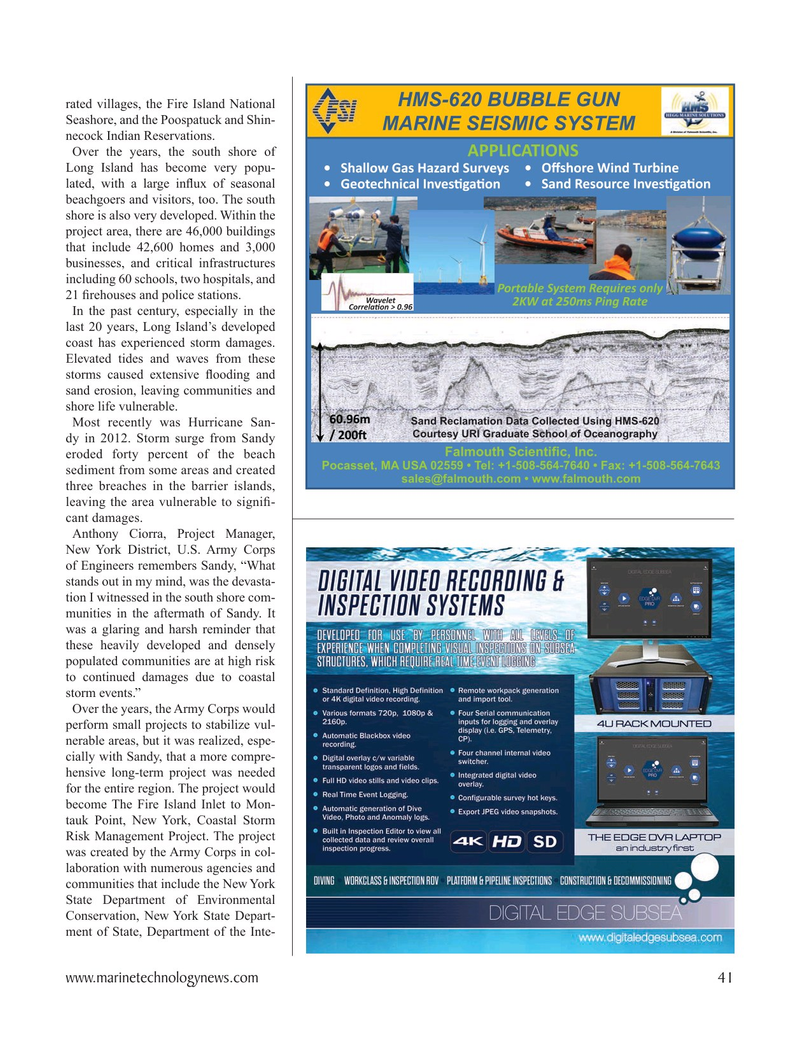
Page 41: of Marine Technology Magazine (March 2022)
Read this page in Pdf, Flash or Html5 edition of March 2022 Marine Technology Magazine
HMS-620 BUBBLE GUN rated villages, the Fire Island National
Seashore, and the Poospatuck and Shin-
MARINE SEISMIC SYSTEM necock Indian Reservations.
Over the years, the south shore of APPLICATIONS
Long Island has become very popu- • Shallow Gas Hazard Surveys • Oi shore Wind Turbine lated, with a large in? ux of seasonal • Geotechnical InvesO gaO on • Sand Resource InvesO gaO on beachgoers and visitors, too. The south shore is also very developed. Within the project area, there are 46,000 buildings that include 42,600 homes and 3,000 businesses, and critical infrastructures including 60 schools, two hospitals, and
Portable System Requires only 21 ? rehouses and police stations.
Wavelet 2KW at 250ms Ping Rate
CorrelaO on > 0.96
In the past century, especially in the last 20 years, Long Island’s developed coast has experienced storm damages.
Elevated tides and waves from these storms caused extensive ? ooding and sand erosion, leaving communities and shore life vulnerable.
Sand Reclamation Data Collected Using HMS-620
Most recently was Hurricane San-
Courtesy URI Graduate School of Oceanography dy in 2012. Storm surge from Sandy
Falmouth Scienti¿ c, Inc.
eroded forty percent of the beach
Pocasset, MA USA 02559 • Tel: +1-508-564-7640 • Fax: +1-508-564-7643 sediment from some areas and created [email protected] • www.falmouth.com three breaches in the barrier islands, leaving the area vulnerable to signi? - cant damages.
Anthony Ciorra, Project Manager,
New York District, U.S. Army Corps of Engineers remembers Sandy, “What stands out in my mind, was the devasta- tion I witnessed in the south shore com- munities in the aftermath of Sandy. It was a glaring and harsh reminder that these heavily developed and densely populated communities are at high risk to continued damages due to coastal storm events.”
Over the years, the Army Corps would perform small projects to stabilize vul- nerable areas, but it was realized, espe- cially with Sandy, that a more compre- hensive long-term project was needed for the entire region. The project would become The Fire Island Inlet to Mon- tauk Point, New York, Coastal Storm
Risk Management Project. The project was created by the Army Corps in col- laboration with numerous agencies and communities that include the New York
State Department of Environmental
Conservation, New York State Depart- ment of State, Department of the Inte- www.marinetechnologynews.com 41
MTR #3 (34-49).indd 41 2/25/2022 3:26:59 PM

 40
40

 42
42
